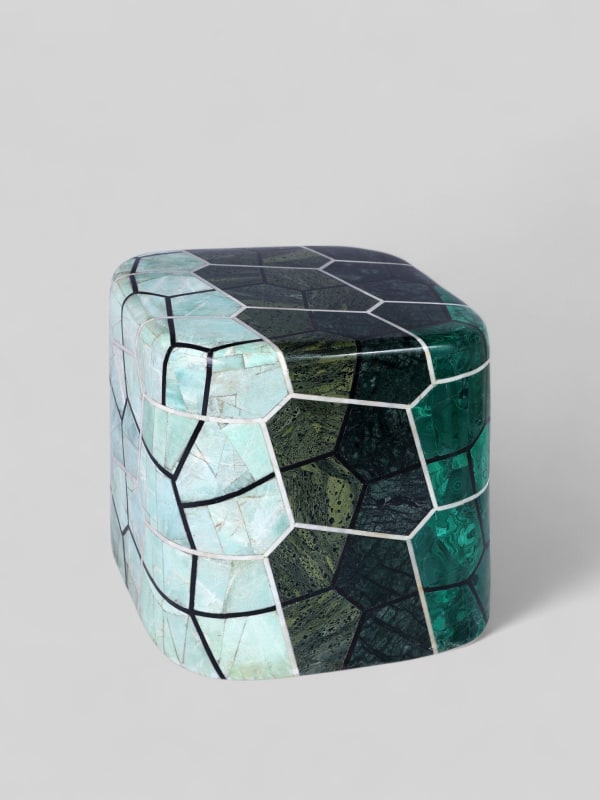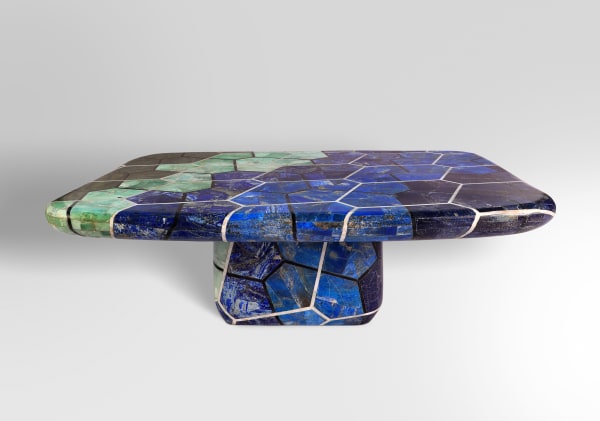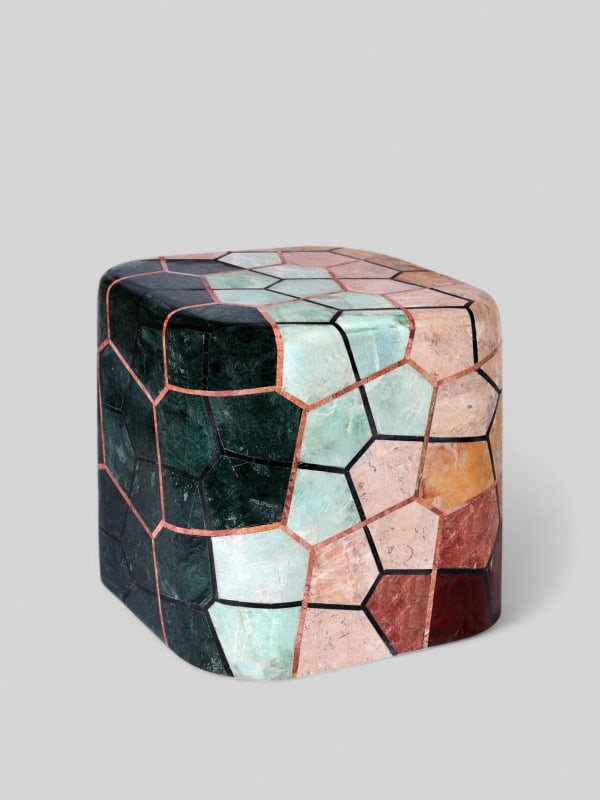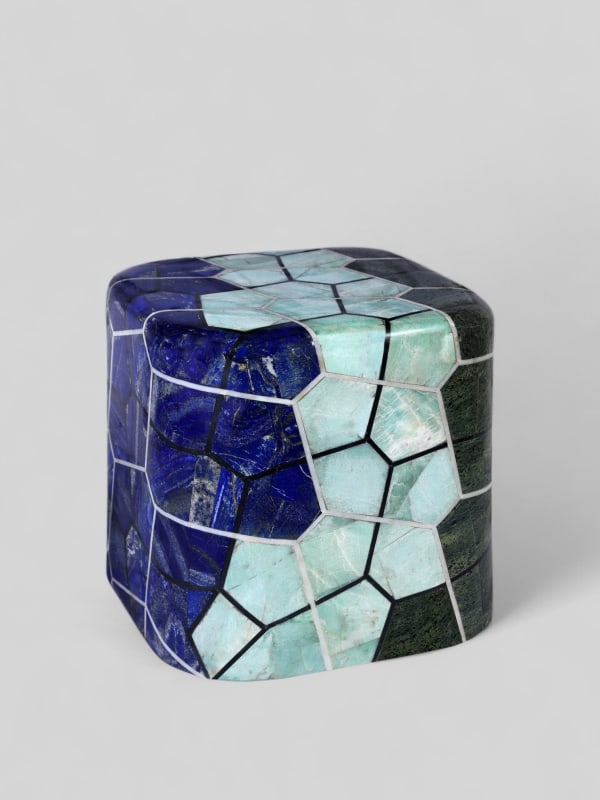Nada Debs x Studio Lél
GANDHARA CARAPACE COLLECTION
‘Gandhara Carapace’ is a collection of tables and seats with minimalist lines, featuring mosaic surfaces of semiprecious stones (lapis lazuli, amazonite, onyx, malachite) and marble. The project uses traditional stone inlay techniques and a palette of refined colors to achieve a distinctly contemporary look and feel. The works incorporate Nada Debs’ iconic Carapace polygonal motif, a symbol of protection with Eastern roots that evokes geometry as a universal language.
The ‘Gandhara Carapace’ collection illustrates Nada Debs’ multicultural approach, recognized worldwide, as well as her talent for revisiting fine crafts in a contemporary light. The collection was born from the collaboration between Nada Debs and Meherunnisa Asad, artistic director of Studio Lél in Pakistan, which for thirty years has been committed to preserving and reinterpreting the art of stone inlay.
NADA DEBS
Nada Debs is world-renowned for her collaborations with regional artisans, crafting furniture and objects that merge traditional techniques with a contemporary multicultural sensibility. For her, craft is an ideal vehicle for uplifting communities, preserving ancient knowledge, and bringing people together across borders, timelines, and identities. It is an approach she calls “handmade and heartmade”, which draws on her own transcontinental experiences — from her upbringing in Japan and her training at the Rhode Island School of Design in the US, to her early career in the US and the UK.
Nada Debs has spent significant periods of her life living and traveling around the world, exploring the connections between different cultures. She currently divides her time between Dubai and Beirut, where her family originates and where she founded her studio twenty years ago. Committed to preserving the region’s artisanal heritage, she reinterprets traditional crafts through her distinctive perspective. Drawing inspiration from the places she has lived — Japan, the United States and the United Kingdom — she breathes new life into the craft traditions of the Levant and beyond. In September 2023, the Institut du Monde Arabe in Paris awarded her the Design Grand Prix d’Honneur.
Nada Debs’ work spans multiple scales and disciplines, from object and furniture design to bespoke commissions across the fields of design, art, fashion, jewellery, and interior architecture. With each project, she intuitively weaves culture and craftsmanship to create emotional resonance, embodying a human story and a sense of belonging. For her, creation goes beyond form and function; it is a celebration of connection – to places, to others, and to our own identity in the world.
The materials she chooses all tell a tactile story. For her, the human hand is a voice, and the artisan a storyteller. She describes craft as a practice that transmits memory, but also as a feeling that transcends geography, language, and culture. Her creative process weaves together ideas, gestures, and techniques gathered from her travels to form a unique cultural dialogue. “My work is driven by a belief in the power of craft to cross time and boundaries and to touch us on a primal level.”
STUDIO LÉL
A multi-disciplinary artist, artistic director of Studio Lél, Meherunnisa Asad is dedicated to perpetuating the legacy of the applied arts by infusing them with a contemporary aesthetic. A graduate of the National College of Arts in Lahore, Pakistan, and Pratt Institute in New York, she first worked as a conservation architect with the Aga Khan Historic Cities Program. She has brought international recognition to Studio Lél, the artistic collective founded thirty years ago in Peshawar by her mother, Farhana. She is a recipient of awards from the Gates Foundation and the World Craft Council.
The art of stone mosaic lies at the heart of her artistic practice. For the Florentines of the Italian Renaissance in the 16th century, who brought Pietra Dura to its peak, this meticulous assembly of stones into complex and refined forms was regarded as an act of painting: a “painting in stone.” The technique was later embraced by the Mughal emperors and spread across the cultural territories of Afghanistan, Pakistan, and India. Building on this shared heritage, Meherunnisa Asad further explores its creative possibilities by combining stone mosaic with a wide range of techniques such as verre églomisé, scagliola, and cloisonné.
Meherunnisa Asad reinvents the art of stone as a dynamic and evolving language, while grounding her practice in cultural and societal engagement. For her, creation is inseparable from community resilience. Her practice is rooted in the Pashtun people, who straddle Afghanistan and Pakistan and whose culture has been shaped by a history of displacement and exile. By working with both local artisans and Afghan artisans displaced in Pakistan, she strengthens the transmission of artisanal crafts and fosters a collective reflection on memory and cultural identity. Through this process, she works toward the reappropriation of forgotten narratives and the reconstruction of Pashtun identity in Pakistan and on the international stage.
-
 Nada Debs x Studio LélGandhara Carapace #7
Nada Debs x Studio LélGandhara Carapace #7 -
 Nada Debs x Studio lélGandhara Carapace #8
Nada Debs x Studio lélGandhara Carapace #8 -
 Nada Debs x Studio lélGandhara Carapace Coffee Table #3
Nada Debs x Studio lélGandhara Carapace Coffee Table #3 -
 Nada Debs x Studio lélGandhara Carapace #2
Nada Debs x Studio lélGandhara Carapace #2 -
 Nada Debs x Studio lélGandhara Carapace #4
Nada Debs x Studio lélGandhara Carapace #4 -
 Nada Debs x Studio lélGandhara Carapace Coffee Table #1
Nada Debs x Studio lélGandhara Carapace Coffee Table #1 -
 Nada Debs x Studio lélGandhara Carapace #5
Nada Debs x Studio lélGandhara Carapace #5 -
 Nada Debs x Studio lélGandhara Carapace #6
Nada Debs x Studio lélGandhara Carapace #6 -
 Nada Debs x Studio lélGandhara Carapace Coffee Table #2
Nada Debs x Studio lélGandhara Carapace Coffee Table #2 -
 Nada Debs x Studio lélGandhara Carapace #1
Nada Debs x Studio lélGandhara Carapace #1 -
 Nada Debs x Studio lélGandhara Carapace Table
Nada Debs x Studio lélGandhara Carapace Table -
 Nada Debs x Studio lélGandhara Carapace #3
Nada Debs x Studio lélGandhara Carapace #3 -
 Nada Debs x Studio lélGandhara Carapace Console
Nada Debs x Studio lélGandhara Carapace Console -
 Nada Debs x Studio lélGandhara Carapace Bench
Nada Debs x Studio lélGandhara Carapace Bench

















